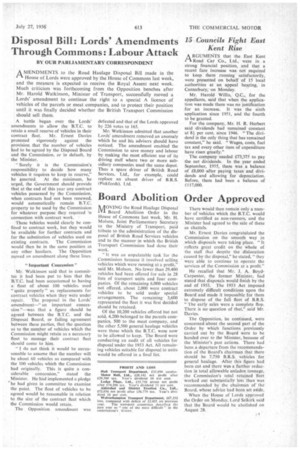Board Abolition Order Approved
Page 39

If you've noticed an error in this article please click here to report it so we can fix it.
MOVING the Road Haulage Disposal Board Abolition Order in the House of Commons last week, Mr. H. Molson, Joint Parliamentary Secretary to the Ministry of Transport, paid tribute to the administration of the disposal of British Road Services vehicles and to the manner in which the British Transport Commission had done their work.
" It was an unpalatable task for the Commission because it involved selling vehicles which were running at a profit." said Mr. Molson. No fewer than 29,400 vehicles had been offered for sale in 28 lists of transport units and four companies. Of the remaining 6,000 vehicles not offered, about 2,000 were contract vehicles to be sold under special arrangements. The remaining 3,600 represented the fleet it was first decided should be retained.
Of the 10,200 vehicles offered but not sold, 4,200 belonged to the parcels companies, 500 to the meat company, and the other 5,500 general haulage vehicles were those which the B.T.C. were now to be allowed to keep. The Board were conducting an audit of all vehicles for disposal under the 1953 Act. All remaining vehicles suitable for disposal in units would be offered in a final list.
There would then remain only a number of vehicles which the B.T.C. would have certified as non-runners, and the Minister had agreed to the sale of these as chattels.
Mr. Ernest Davies congratulated the Commission on the smooth way in which disposals were taking place. "it reflects great credit on the whole of the staff that despite the dislocation caused by the disposal," he stated, " they were able to continue to operate the services of the Commission at a profit."
He recalled that Mr. J. A. BoydCarpenter, the former Minister, had stated that disposals would finish by the end of 1953. The 1953 Act imposed extremely difficult conditions upon the Board and made it impossible for them to dispose of the full fleet of B.R.S. "The early sales were a complete flop. There is no. question of that," said Mr. Davies.
The Opposition, he continued, were concerned about the second part of the Order by which functions previously carried out by the Board were to be handed over to the Minister, because of the Minister's past actions. There had been a departure from the recommendation of the Board's chairman that there should be 7,750 B.R.S. vehicles for general haulage. After this figure had been cut and there wa9 a further reduction in total allowable unladen tonnage, the Commission's total retained fleet worked out substantially less than was recommended by the chairman of the Board, whose advice had been set aside.
When the House of 1.ords approved the Order on Monday. Lord Selkirk said that the Board would be abolished on August 28.












































































































